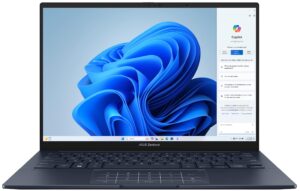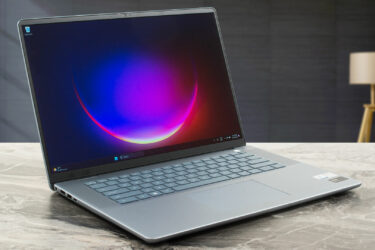ASUS Zenbook 14 OLED (UX3405) review – premium 14-incher with superb OLED panel and Meteor Lake-H CPU options
Verdict
 The ASUS Zenbook 14 OLED (UX3405) is a compact and light 14-icnher that is offered with all-new Intel Meteor Lake-H CPU options. The device feels very responsive for regular home or office usage. We tried to open some Web sites and play a few YouTube videos while Cinebench R2024 was running in the background and everything was working smoothly. In our case, the Intel Core Ultra 7 155H can be found under the bonnet. This powerful chip is a true challenge for the cooling system, especially because the profile thickness of the laptop is sub-15 mm.
The ASUS Zenbook 14 OLED (UX3405) is a compact and light 14-icnher that is offered with all-new Intel Meteor Lake-H CPU options. The device feels very responsive for regular home or office usage. We tried to open some Web sites and play a few YouTube videos while Cinebench R2024 was running in the background and everything was working smoothly. In our case, the Intel Core Ultra 7 155H can be found under the bonnet. This powerful chip is a true challenge for the cooling system, especially because the profile thickness of the laptop is sub-15 mm.
In short and medium loads, the core clocks are higher than the base ones but the CPU hits 102°C after 30 seconds of 100% stress. Still, in longer periods of max load, the processor thermals are way lower but the P core clock is below the official base value while the frequencies of the E and LP E cores are okay. You get three fan profiles at your disposal. The “Performance mode” could be too noisy for people who prefer to work in a quiet environment. The “Whisper” mode looks like the sweet spot between power and low noise levels.
Overall, the performance of the CPU isn’t as good as we expected it to be. Some other 14-ichers with Raptor Lake P CPUs like the MSI Summit E14 Flip Evo (A13M) and Dell Latitude 14 5440 can show higher scores in 3D Rendering. That’s because the cooling of the ASUS Zenbook 14 OLED (UX3405) is having a hard time when it comes to longer 100% CPU stress.
On the other hand, the Intel Arc (8-Cores) is mind-blowingly fast for an integrated solution. Interestingly, in the MyASUS app, you can find a “Memory Allocated to GPU” option. You can manually adjust the dedicated system RAM for the iGPU. The max value is 8GB which seems a lot and can be handy for some games that are always “hungry” for more VRAM.
The optional 1800p OLED panel (Samsung ATNA40CU06-0 (SDC419D)) offers full sRGB and DCI-P3 coverage alongside fast pixel response times paired with a 120Hz frequency. In addition, the infinite contrast ratio and the good max brightness can be appreciated by all users, especially the ones who like to watch movies. The “Flicker-Free Dimming” option solves the issue with the typical OLED PWM flicker.
The upgradability is poor which is normal for most super-thin laptops like this one. The RAM is soldered and you can rely on a single M.2 slot for Gen 4 SSDs. On the other hand, the chassis rigidity is fine and the input devices are comfortable for work. This notebook shines bright thanks to its great battery life – 25 hours of Web browsing on a single charge is a great result! Of course, the Intel Evo certifications also help in this situation. Last but not least, the I/O includes two Thunderbolt 4 ports.
The ASUS Zenbook 14 OLED (UX3405) is a compact machine with powerful hardware, a great OLED display, and a very long battery life.
You can check the prices and configurations in our Specs System: https://laptopmedia.com/series/asus-zenbook-14-oled-ux3405/
Pros
- The iGPU is crazy-fast
- Infinite contrast ratio (Samsung ATNA40CU06-0 (SDC419D))
- 2880х1800K resolution and a 120Hz refresh rate (Samsung ATNA40CU06-0 (SDC419D))
- Full sRGB and DCI-P3 coverage (Samsung ATNA40CU06-0 (SDC419D))
- 180-degree hinge
- Comfortable input devices + optional ASUS NumberPad
- Modern I/O + Type-C charging
- Great battery life
- The fan is quiet in “Whisper mode”
- 1080p IR Web camera
- Good sound quality
- Meteor Lake CPU options
- Good processor clocks in short and medium loads
Cons
- PWM usage is observed if the “OLED Flicker-Free Dimming” option is turned off (Samsung ATNA40CU06-0 (SDC419D))
- Unimpressive CPU frequencies in prolonged periods of 100% stress
- High NVMe temperature during benchmarking
- The Intel Core Ultra 7 155H hits 102°C after 30 seconds of max load
- Soldered RAM and just one M.2 slot








